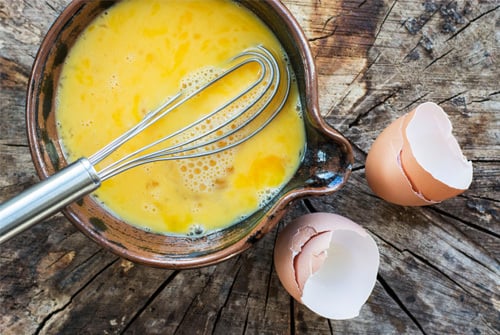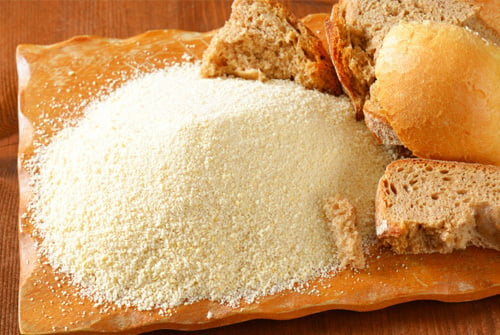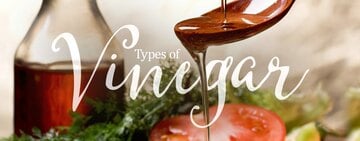What You Need to Know About Eggless Cooking
Last updated on Nov 26, 2024Rachel JenkinsWhen running a restaurant, it’s always important to accommodate guests with allergies or restrictive diets. From diners to bakeries, eggs are an ingredient most chefs can’t live without. But with eggs being one major food allergy, it’s imperative your restaurant find and use suitable alternatives without sacrificing taste or quality. Below are a few egg substitutes that can be used to add moisture, leaven, and bind ingredients together.
Function of Eggs in Cooking

Eggs are generally used for the following reasons in cooking:
- Moisture: The liquid from eggs helps keep your final product moist.
- Leavening: Because eggs trap air in foods, it can help your recipe to rise during baking.
- Binding: Eggs provide structure by holding ingredients together to prevent your final product from falling apart.
To determine why eggs are being used in a particular recipe, simply take a look at the other ingredients. If there are no other liquids, they’re used to add moisture. If your baked goods are void of other leavening agents such as baking powder or soda, then the eggs are most likely being combined with acidic ingredients to make your recipe rise. And if your recipe is short on flour, nuts, or breadcrumbs, the eggs are being used to bind ingredients together.
What Is Egg Replacer?
Egg replacement powders contain binding ingredients such as potato starch or soy powder. These replacers can be mixed with water and react the same way as an egg would when used as a binder or leavening agent, though it is designed for use in baked goods.
This powder doesn't have a flavor, so this option won't affect the appearance or taste of your final product. A single box has the equivalent of over a hundred eggs for about the price of two dozen regular eggs, so this is an easy means of cutting costs.
Effective Egg Substitutes
The following ingredients can be used for eggless cooking and baking in your kitchen. We’ve broken them down by purpose, including moisture, leavening, and binding.
Egg Substitutes for Adding Moisture
When your recipe needs moisture added, but you don’t have the eggs, you’ll need another liquid. Fruit juices or purees are good replacements when making baked goods like cookies, muffins, and quick breads.
If you’re looking to add moisture to a recipe, incorporate ¼ cup per egg when using the following egg substitutes:
- Mashed banana
- Unsweetened applesauce
- Pumpkin puree
- Mashed avocado
Egg Substitutes for Leavening
Eggs are used as leavening agents in recipes for cookies, cupcakes, and cakes. If that's what you're making, you can try one of these for a similar result:
- Buttermilk (1/4 cup)
- Yogurt (1/4 cup)
- 2 Tbsp. of baking powder, 3 Tbsp. of water, and 1 Tbsp. of oil
- 1 Tbsp. of vinegar and 1 Tbsp. of baking soda
Egg Substitutes for Binding

Eggs are used as binders in many recipes, like meatloaves, casseroles, burgers, and drop cookies.
Use the following egg substitutes when making savory dishes:
- Mashed potatoes (2 Tbsp.)
- Nut butters (3 Tbsp.)
- Silken tofu (1/4 cup)
- Soy lecithin (1 Tbsp.)
The following egg substitutions are ideal for sweet dishes:
- 1 Tbsp. of custard powder and 2 Tbsp. of water
- 1 Tbsp. of gelatin and 1 Tbsp. of water
- 1 Tbsp. of ground flax seed with 3 Tbsp. of water
- 2 Tbsp. of arrowroot powder with 3 Tbsp. of water
Substitutions for Egg Whites or Egg Yolks
Many recipes may call for a specific part of the egg, either the whites or the yolk. If a recipe calls for egg whites, aquafaba is the best substitute to use. Aquafaba refers to the juice left over from cooked beans such as chick peas, lentils, black beans, or kidney beans. The mixture of proteins, sugar, and starch mimics the same effects when whipped like egg whites.
On the other hand, soy lecithin is an ideal substitute for mimicking the thick, rich texture of egg yolks. It is recommended you use 1 Tbsp. of soy lecithin per egg in a recipe.
There are limitations to the dishes you can use these substitutions on. For instance, you wouldn’t be able to make an angel food cake, where eggs are the base. However, if your restaurant or bakery is trying to cut costs on egg usage in foods like burgers and chocolate chip cookies, these egg substitutes are an ideal solution.
Related Resources

How to Separate Egg Whites
When preparing meringue, custard, and other British baked goods, separating egg whites from yolks is often necessary. While it's challenging to separate egg whites without ending up with any pieces of yolk, even the smallest pieces of yolk can ruin your recipe. We provide several methods for separating egg whites both with tools and without, so your recipes come out perfectly. How to Get Egg Whites Use our video tutorial to implement the most popular tactics for separating egg yolks from whites. Whether you invest in an egg white separator, use common kitchen tools, or forgo tools altogether, there is a simple and effective method for separating egg whites for all experience levels. <iframe itemprop="embedURL" width="560" height="315" src="https://www.youtube.com/embed/zYsP_0oQ5kA?rel=0" frameborder="0" allowfullscreen></iframe> Ways to Separate Eggs You must be careful when separating eggs. While getting some egg whites with your yolks shouldn’t impact your recipe too severely, getting egg yolks in egg whites can ruin your delicate French macarons and smooth meringues because the fat from the yolk minimizes the egg white’s ability to fluff into stiff peaks. We provide the most popular ways to separate eggs so you can decide which method works best for your kitchen. Separating Eggs with Hands The best way to separate eggs from whites is to use your hands, allowing the whites to pass through your fingers. We recommend this method because it is fast, effective, and requires no additional tools. Always remember to practice proper handwashing procedures before moving on to additional baking steps. Follow these simple steps for the best way to separate eggs: Wash your hands with soap and hot water before you begin. Crack the egg on a flat surface. Over a bowl, open the egg into your hand and allow the egg whites to pass through your fingers. Gently move your fingers to work all the egg whites through. Deposit the egg yolk into a separate bowl. Separating Eggs with an Egg Separator The best way to separate eggs without dirtying your hands is with an egg separator. Egg separators are kitchen tools specifically designed to help chefs separate egg whites and yolks. There are multiple styles of egg separators available for you to try. Crack the egg on a flat surface. Over a bowl, open the egg into the egg separator. Allow the egg whites to drip through the openings. Deposit the yolk in a separate bowl. Separating Eggs with a Water Bottle You can separate egg whites with a water bottle by sucking the yolk into the bottle. While it can be effective with practice, it is easy to suck up egg whites with the egg yolk or break the yolk. Follow these steps to separate eggs with a water bottle: Crack the egg on a flat surface. Open the egg onto a plate. Grab a clean bottle and squeeze it slightly. Hold the bottle opening over the yolk and slowly release your grip to suck up the yolk. Deposit the yolk in a separate bowl by slowly squeezing and tilting the bottle. Separating Eggs with a Slotted Spoon If you want to keep your hands clean, you can try separating egg whites with a slotted spoon. This method isn't always effective, since the egg whites may be too thick to run through the openings of the slotted spoon. If you don't have an egg separator on hand and want to try using a slotted spoon to separate your eggs, follow these steps: Crack the egg on a flat surface. Over a bowl, open the egg onto a slotted spoon. Slightly rock the spoon to encourage the egg whites to fall through the slots and over the sides. Deposit the yolk in a separate bowl. Separating Eggs with a Turkey Baster The bulb of a turkey baster provides an ergonomic tool for separating eggs if you don't have an egg separator on hand. The downside of using your turkey baster to separate eggs is you must take it apart and it can be difficult to clean after you're done. Follow these steps to use a turkey baster to separate eggs: Remove the bulb from a turkey baster. Crack the egg on a flat surface. Open the egg onto a plate. Squeeze the bulb of the baster slightly and let go slowly to suck the yolk into the bulb. Deposit the yolk in a separate bowl by slowly squeezing and tilting the baster bulb. Separating Eggs with a Funnel Funnels are a common kitchen tool that is easy to use for separating eggs. Since some egg whites are very thick, they may require some pulling to separate from the egg yolk. You may need to stir the egg in the funnel, which can lead to the yolk breaking. Follow these steps to separate eggs with a funnel: Crack the egg on a flat surface. Open into a funnel. Allow the egg whites to run through the funnel opening. Deposit the yolk in a separate bowl. Separating Eggs with the Shell You can use the egg's shell to separate the egg whites. The benefit of this egg-separating method is it requires no additional tools. However, it is one of the harder methods to execute, because the edge of the shell may pierce the egg yolk, causing it to get into your whites. It also poses a food safety risk, because harmful bacteria like salmonella can linger on the shell and get in contact with the white or yolk. Crack the egg on a flat surface. Over a bowl, separate the shell at the widest point to create two halves. You will want to angle the egg upward and lift off the top half. Pass the egg yolk back and forth between the two halves, allowing the egg white to drip down into the bowl. Repeat until you are left with just the yolk in the shell. Deposit the yolk in a separate bowl. How to Crack Eggs Before you can separate egg whites and yolks, you have to crack the egg shells. Follow these two tips to crack eggs without ending up with pieces of shell in the bowl: Use Chilled Eggs - The key to a clean egg separation is to start with a cold egg that has been refrigerated for at least 20 minutes to ensure that the egg yolk is firm and less likely to break. Use a Flat Cracking Surface - Crack the egg on a flat surface to keep eggshell shards out of the egg whites. If you crack an egg on the corner of a bowl or countertop, it often pushes the eggshell pieces into the egg. Why Separate Egg White and Yolk in Baking? Separating eggs is a common baking technique that can make a big difference in the final outcome of your baked goods. While it may seem like an extra step, it is worth the effort. It is a simple yet effective way to control the texture, flavor, and structure of your baked goods. Discover the benefits of using egg whites and yolks separately below: Changes Texture - Separating eggs allows you to control the texture and structure of your baked goods. Egg whites are known for their ability to create light and airy textures, while egg yolks add richness and moisture. By separating the eggs, you can use each component separately, tailoring the recipe to achieve the desired result. Customizes Flavor - Egg yolks contain fat and can sometimes have a slightly "eggy" taste, which may not be desirable in certain recipes. By separating the eggs, you can remove the yolks and avoid any potential flavor interference. Aids Emulsification - Emulsification is the process of combining two liquids that normally wouldn't mix, such as oil and water. Egg yolks contain emulsifiers that can help stabilize and bind ingredients together, creating a smooth and cohesive batter or dough. Helps Baked Goods Rise - Separating eggs also plays a role in achieving the perfect rise and structure in certain baked goods. For example, in recipes that call for beaten egg whites, such as angel food cake or meringue, separating the eggs allows you to whip the whites to their full potential. This creates a light and fluffy texture that is essential for these delicate desserts. Caters to Alternative Diets - If customers are watching their cholesterol intake or following a specific diet that requires them to limit egg yolks, separating the eggs allows them to still enjoy baked goods or a breakfast scramble without compromising their dietary needs. How to Store Separated Eggs If you aren't using your separated eggs immediately, here is how you can store separated egg yolks and whites: How to Store Egg Yolks - You can store egg yolks in the refrigerator for 2 to 4 days before use. Simply place the egg yolks in a bowl and fill the bowl with enough water to cover the yolks. Pour out the water before using the eggs. Egg yolks do not freeze well. How to Store Egg Whites - You can store egg whites in the refrigerator for 2 to 4 days or in the freezer for 12 months. Pour the egg whites into an ice cube tray and allow them to freeze. You can then place the cubes in a freezer bag. Thaw the cubes before using them. Many recipes call for pastry chefs to separate egg whites and yolks. You'll need egg whites to make meringues and angel food cake. Egg yolks are required for making custards, our decadent brown sugar cinnamon bread pudding recipe, and our pumpkin creme brulee recipe. Learning how to separate eggs properly is the secret to creating the ideal texture, flavor, and structure of many classic desserts.

Is Baking Soda the Same as Baking Powder?
Whether you own a bakery, offer baked goods on your menu, or just have a casual interest in baking, it’s essential to understand the difference between baking soda and baking powder. In the blog below we’ll explain what sets baking soda and baking powder apart, how they work, and the different substitutes you can use in their place. Baking Soda vs Baking Powder The difference between baking powder and baking soda comes down to their ingredients. Baking soda only contains one ingredient, sodium bicarbonate. On the other hand, baking powder is made up of two ingredients: sodium bicarbonate and some form of powdered acid. In most cases, that acid is potassium bitartrate, also known as cream of tartar. How Baking Soda Works Baking soda undergoes a chemical reaction when mixed with an acidic ingredient. This reaction only takes place in the presence of moisture and produces carbon dioxide gas, which helps your batter or dough to rise and appears as air bubbles in the recipe. Once you’ve added baking soda to your dough, it’s best to bake it as soon as possible as the carbon dioxide will eventually escape. If this happens long enough, it can prevent your baked goods from rising. The list of ingredients that can help induce this reaction includes: Lemon juice Buttermilk Yogurt Honey How Baking Powder Works Similarly to baking soda, the activation process of baking powder produces carbon dioxide gas that helps raise your batter or dough. Unlike baking soda, baking powder already contains an acidic ingredient. Because of this, it only requires water to activate. It’s important to note that some baking powders are double-acting. This means that they will activate a second time when introduced to heat. Because of this second activation, you don’t need to rush to get your baked goods in the oven when you’re using double-acting baking powder. Baking Powder Substitute While it’s possible to substitute baking powder in your recipes, any ingredient used in its place will not be as effective. Regardless, if you don’t have access to baking powder, you may need to find a convenient alternative. Below, we’ve listed some ingredients commonly found in kitchens that can act as a suitable substitute for baking powder. Buttermilk and baking soda: As a fermented dairy product, buttermilk can have a similar leavening effect as baking powder when combined with baking soda. Cream of tartar: Created as a byproduct of the wine-making process, cream of tartar is an acidic white powder. Combining it with baking soda allows you to mix an excellent replacement for baking powder. Lemon juice: With a high concentration of citric acid, lemon juice is acidic enough to trigger a leavening effect when combined with baking soda. Keep in mind that it should only be used in small amounts to avoid giving your recipes a lemon flavor. Molasses and baking soda: Typically used as a sweetener, molasses can cause an acid-based reaction when combined with baking soda, making it an effective substitute for baking powder. Sour milk: Because of its diminished pH levels, sour milk reacts with baking soda to produce a similar leavening effect as baking powder. Vinegar and baking soda: Vinegar, which has an acidic pH, can be a possible substitute for baking powder when paired with baking soda. Baking Soda to Baking Powder Conversion For every 1 teaspoon of baking soda, substitute 3 teaspoons of baking powder. Baking Soda Substitute Though some recipes can still be prepared without baking soda, it's best to make sure you have a suitable replacement on hand just in case. Remember that a baking soda reaction requires acid to activate, so it's essential to have acidic foods on hand during the process. Below, we've listed some baking soda substitutes that you might find around the kitchen: Baking powder: Baking powder is one of the most common substitutes for baking soda. It’s best to use it as a substitute in sugar-based recipes. In the section below, we’ve included a baking soda to baking powder conversion. Self-rising flour: Though the conversion can be tricky, self-rising flour can serve as a substitute for baking soda. It is made of a combination of all-purpose flour, baking soda, and salt. Egg whites: In some cases, egg whites can serve as a viable replacement for baking soda. Whipped egg whites can help add structure to your recipe, but must be folded in gently to avoid agitating the batter. Club soda: As it contains a small amount of baking soda, club soda can sometimes be used as a substitute in a pinch. It's important to note that club soda will only work as a replacement for recipes that require minimal rising. Baking Powder to Baking Soda Conversion Use 1 teaspoon of baking soda for every tablespoon of baking powder. To make sure it functions correctly, also add 2 teaspoons of vinegar, lemon juice, cream of tartar, or another acidic ingredient to your batter or dough. One drawback to using baking powder as a substitute is that it isn't double-acting. With that in mind, be sure to get it in the oven as soon as possible after you combine it with wet ingredients. How Long Does Baking Soda Last? In general, an unopened package of baking soda can be stored at room temperature for up to 18 months. However, once the package has been opened, its shelf life is reduced to 6 months. Environmental factors can speed up the rate at which ingredients lose their effectiveness, making it essential that you store your baking soda in a suitable space. How to Test Baking Soda To test baking soda, mix 1/4 teaspoon of baking soda with 2 teaspoons of vinegar. It should bubble immediately if your baking soda is useable. What Happens If You Use Expired Baking Soda? Baking soda can still be used after its expiration date, though it won't work as well as fresh baking soda. Despite its reduced effectiveness, expired baking soda is still safe to consume. How Long Does Baking Powder Last? An unopened package of baking powder can typically be used until 18-24 months after manufacturing. However, for the best results, it’s recommended that you use your baking soda before expiration. How to Test Baking Powder To test baking powder, mix 1 teaspoon of baking powder with 1/2 cup of hot water. If it bubbles, your baking powder is still effective. What Happens If You Use Expired Baking Powder? Expired baking powder is safe to consume, but using it in your recipes can cause baked goods to come out flat or dense. Baking Soda and Baking Powder FAQ In the section below, we've answered some of the most frequently asked questions about baking powder and baking soda. How to Store Baking Soda Since baking soda absorbs odors and moisture, it's best to store it in a cool, dry location. The best temperature for storing baking soda falls somewhere between 40-70 degrees Fahrenheit. Once you’ve opened a package of baking soda, be sure to store it in an air-tight and moisture-proof container to preserve freshness. How to Store Baking Powder Similar to baking soda, baking powder should be stored in a cool, dry location. Avoid storing it in a refrigerator, as it’s possible moisture could develop and cause a reaction within the baking powder. What Is a Leavening Agent? A leavening agent, sometimes referred to as a leavener or a rising agent, is used in baking to expand doughs and batters. When mixed with liquid, acid, or heat, they release gas, causing the dough to rise. Many people say that baking is a science, and how baking soda and baking powder work as chemical leavening agents is an excellent example of science at work in your kitchen. Recipes use these ingredients to give your baked goods the perfect texture brought on by chemical reactions and carbon dioxide gas. As a result, precision is key when working with baking soda and baking powder. Next time you use one of these ingredients, remember our storage tips and directions for how to make sure that your baking soda or baking powder is still working.

Types of Vinegar
Vinegar is a go-to ingredient when you want to increase the acidity in your recipes or preserve foods through pickling. It can help to cut the saltiness of over-seasoned dishes, and it can be combined with salad oil to create a tangy vinaigrette. Vinegar has a long shelf-life, which makes it convenient to keep on hand. To top it off, there are many different kinds of vinegar to choose from. We'll introduce the different kinds of vinegar and explain what makes each type unique. Shop All Bulk Vinegar Click below to learn more about the different types of vinegar: Distilled White Vinegar Apple Cider Vinegar Balsamic Vinegar White Wine Vinegar Red Wine Vinegar Rice Vinegar Malt Vinegar Red Rice Vinegar Champagne Vinegar Sherry Vinegar Black Vinegar Cane Vinegar Beer Vinegar Vinegar FAQ What Is Vinegar Made Of? Vinegar is made of water and acetic acid. All types of vinegar start as a liquid containing natural yeasts and sugars, like unpasteurized fruit juice. The liquid goes through a fermenting process where the yeast consumes the sugar and produces ethanol (alcohol). The sour, pungent flavor of vinegar is deepened through a second fermentation that transforms the alcohol into acetic acid. The flavor profile of each kind of vinegar is determined by the type of juice or liquid that is used. Different Types of Vinegar Have you ever wondered about the difference between apple cider vinegar and white vinegar? We've made a list of vinegar types and their flavor profiles to help you choose the best vinegar for the job. 1. Distilled White Vinegar White vinegar is the most common type of vinegar, and there’s a good chance it’s sitting in your kitchen right now. It offers a sharp taste and potent smell, making it one of the most distinct vinegar types on this list. That’s because white vinegar is distilled from grain, which results in a crisp and clear product. White vinegar has a strong flavor, so it's best used in small doses to add a touch of acidity to recipes. It’s a common preserving agent and can be used to pickle foods. Distilled vinegar can also be used in baking applications to provide leavening (rise) to cakes and cupcakes. White vinegar is an effective cleaner for surfaces and cookware, and it can be used in your coffee maker to remove scale buildup. White Vinegar Flavor: Sharp and potent Best White Vinegar Uses: Preserving and pickling, cleaning, leavening baked goods What Is White Vinegar Made From? Grain alcohol 2. Apple Cider Vinegar Apple cider vinegar is the next most common type of vinegar on our list. It’s made by adding a bacteria and yeast culture to crushed, strained apples. Added sugars and natural sugars are consumed by the bacteria and yeast, producing ethanol. The ethanol is fermented a second time to produce acetic acid, the compound that gives vinegar its sour flavor. Apple cider vinegar has a golden hue and can be used to add a tart and subtle fruity flavor to marinades, salad dressings, coleslaw, and chutneys. Apple Cider Vinegar vs White Vinegar Apple cider vinegar is different than white vinegar because it retains a sweet, fruity flavor from the apples. White vinegar is stronger than apple cider with a higher percentage of acetic acid. Reach for apple cider vinegar when you want to add flavor to salad dressings and sauces. Choose distilled white vinegar when you want to pickle foods or add acidity without imparting any extra flavors. Apple Cider Vinegar Flavor: Tart and fruity Best Apple Cider Vinegar Uses: Health tonics, salad dressings, and marinades What Is Apple Cider Vinegar Made From? Crushed apples, sugar, and yeast 3. Balsamic Vinegar This Italy native is the only type of vinegar that is not produced by fermenting alcohol. Like a fine wine, balsamic vinegar is made by aging pressed grapes in oak barrels. And just like wine, the older the balsamic, the higher the price tag. True balsamic vinegar will carry a label that reads D.O.P. (Protected Designation of Origin). This certifies that the balsamic vinegar was produced according to protected standards. Balsamic vinegar has a distinct sweet and zesty flavor that can be drizzled over both savory and sweet dishes. Or, mix it with olive oil for a classic balsamic vinaigrette dressing. Balsamic Vinegar Flavor: Concentrated, complex, and sweet Best Balsamic Vinegar Uses: Salad dressings, glazes, reductions What Is Balsamic Vinegar Made From? Grape must (pressed grape juice) 4. White Wine Vinegar Not to be confused with distilled white vinegar, this vinegar has a much milder flavor. White wine vinegar is made with fermented white wine and is much less acidic than both white and apple cider vinegar. The light, balanced sweetness of white wine vinegar makes it a refreshing addition to salad dressings and soups. White Vinegar vs White Wine Vinegar Both of these types of vinegar have "white" in their name, but their flavor is very different. Distilled white vinegar is very strong and can easily overpower foods if you use too much. White wine vinegar is milder than distilled vinegar and has more culinary uses because of its complex flavor. Reach for the white vinegar for canning or cleaning, and use white wine vinegar for creating delicious sauces and marinades. White Wine Vinegar Flavor: Sweet and mild Best White Wine Vinegar Uses: Pickling and brining, salad dressings, condiments, sauces, marinades What Is White Wine Vinegar Made From? White wine Back to Top 5. Red Wine Vinegar Red wine vinegar is similar to its white wine counterpart. It’s derived from a red wine base and offers a sweet, less acidic taste. This Mediterranean staple has a mellow flavor profile that is perfect for use in vinaigrettes and reductions. Is Red Wine Vinegar the Same as Red Cooking Wine? No, red wine vinegar and red cooking wine are not the same ingredients. Red wine vinegar is made from fermented red wine, so it has a tangy flavor that enhances vinaigrettes and marinades. Red cooking wine, on the other hand, is a product that contains red wine along with preservatives, sodium, and sweeteners. Experienced chefs recommend using drinking wine instead of cooking wine for a higher quality dish. Red Wine Vinegar Flavor: Tangy and sweet Uses for Red Wine Vinegar: Mignonette (condiment served with raw oysters and clams), pickling vegetables, salad dressings, marinades, sauces What Is Red Wine Vinegar Made From? Red wine 6. Rice Wine Vinegar A familiar ingredient in Asian cuisine, rice vinegar is made by fermenting rice into alcohol, then fermenting the alcohol into acidic acetic acid. Rice wine vinegar has a sweeter flavor than white wine or red wine vinegar. It's also the key ingredient in the sushi rice vinegar that gives the dish its flavor and texture. Rice Wine Vinegar vs Rice Wine Rice wine and rice vinegar are two different ingredients. Rice wine is made from fermented rice, which produces a sweet flavor. Rice wine vinegar goes through a second fermentation, which adds more tang. These two ingredients cannot be substituted for each other. Rice Vinegar Flavor: Sweet and delicate Best Rice Vinegar Uses: Sushi rice, salad dressings, sauces, marinades What Is Rice Vinegar Made From? Fermented rice 7. Malt Vinegar Malt vinegar gets its name from malted barley. To make this amber-colored vinegar, grains of malted barley are fermented into ale, then fermented a second time to develop the tart, toasty flavor. Malt vinegar is the type of vinegar served with fresh-cut french fries or with the classic British dish, fish and chips. But don't neglect this vinegar in your cooking. You can also use malted vinegar to pickle vegetables and flavor sauces. Malt Vinegar Flavor: Toasty and rich Best Malt Vinegar Uses: Flavor enhancer for chips and french fries, pickled vegetables, salad dressings, condiments, sauces What Is Malt Vinegar Made From? Malted barley 8. Red Rice Vinegar Red rice vinegar is also known as Chinese red vinegar. Even in Chinese cooking, it's not a commonly used vinegar. But in certain traditional recipes, it's a necessity and cannot be substituted. Congee (rice porridge) and Chinese fried squab (pigeon) are two dishes enhanced with red rice vinegar. The key ingredient of red rice vinegar is rice cultivated with red mold. This rice is referred to as red yeast rice and it gives red vinegar its signature salty flavor. Red Rice Vinegar Flavor: Tart and salty Best Red Rice Vinegar Uses: Chinese dishes and condiments What Is Red Rice Vinegar Made From? Fermented red rice Back to Top 9. Champagne Vinegar Champagne vinegar is a type of white wine vinegar made from the same grapes used to make Champagne. It's not actually made with a bottle of bubbly Champagne, which is a common misconception. But like Champagne, this vinegar is sweet and effervescent. It won't overpower the flavors in your delicate sauces and marinades. Substitute for Champagne Vinegar In recipes calling for Champagne vinegar, the best substitute to replicate the delicate flavor is rice wine vinegar. You can use white wine vinegar, but its flavor is more acidic so opt for a lesser amount than you would normally use. Champagne Vinegar Flavor: Floral and sweet Best Champagne Vinegar Uses: Quick pickles, salad dressings, sauces What Is Champagne Vinegar Made From? Chardonnay or pinot noir grapes 10. Sherry Vinegar A close cousin of balsamic vinegar, sherry vinegar is an ingredient that can pack a big punch into your favorite recipes. Its nutty, rich flavor offers less sweetness than balsamic vinegar. It’s also potent, which means that it should be used sparingly – especially as a substitution. The recipe for sherry vinegar was discovered by accident. This Spanish native vinegar is said to be the result of a few barrels of sherry that were spoiled and became too acidic. While this ruined the after dinner drink, it produced a new favorite ingredient for chefs. Sherry Vinegar Flavor: Pungent and nutty Best Sherry Vinegar Uses: Salad dressings, glazes, marinades, reductions What Is Sherry Vinegar Made From? Fortified wine 11. Black Vinegar (Chinkiang) Black vinegar, also known as Chinkiang vinegar, hails from the eastern Chinese city of Zhenjiang. It offers an earthy and smoky umami flavor thanks to a combination of fermented glutinous rice, wheat, and millet. This pantry staple for Chinese cuisine can be used to pair with dumplings, duck, and Asian dipping sauces. Substitute for Chinese Black Vinegar Black vinegar has such a unique flavor that it's hard to replicate its aromatic qualities with other types of vinegar. But in a pinch, you can substitute a combination of rice wine vinegar with soy sauce. Black Vinegar Flavor: Earthy and umami Best Black Vinegar Uses: Flavor enhancer for stir-fry, meats, and sauces What Is Black Vinegar Made From? Fermented black sticky rice or glutinous rice, sometimes with other added grains 12. Cane Vinegar This type of vinegar is produced by fermenting the syrup extracted from crushed sugar cane. While cane vinegar is derived from sugar cane, it offers a surprisingly un-sweet flavor profile often compared to malt vinegar. Cane vinegar is more common in countries where sugar cane is grown. It's a staple ingredient in Filipino dishes like chicken adobo (chicken simmered in vinegar). Cane Vinegar Flavor: Mellow and fresh Best Cane Vinegar Uses: Traditional Filipino dishes, sauces, marinades What Is Cane Vinegar Made From? Sugar cane 13. Beer Vinegar Just as it sounds, beer vinegar is made by fermenting any type of finished beer. It offers a very similar flavor profile to barley-based malt vinegar, which makes it an ideal alternative to use with classic fish and chips. Beer vinegar can be made with any type of beer, which results in a range of flavors. From stouts to pale ales, each type will create a unique taste. Beer Vinegar Flavor: Nutty and complex Best Beer Vinegar Uses: Flavor enhancer for What Is Beer Vinegar Made From? Beer Back to Top Vinegar FAQ We answer some common questions about vinegar below. Check out our vinegar chart to compare the colors of the most popular types of vinegar. How Is Vinegar Made? Vinegar is made using a two-step fermentation process. First, a liquid mixture containing yeast and sugar is fermented into alcohol. Then the alcohol goes through a second fermentation which produces a sour- or bitter-tasting product packed with acetic acid. Does Vinegar Go Bad? Just because your vinegar has turned cloudy or the color appears to change doesn’t mean it has gone bad. Thanks to the acidic nature of vinegar, it can be kept on your shelf indefinitely. Store it in a cool, dry place away from heat and light, and always keep a tight lid on the bottle. Over time, the appearance of your vinegar may change, including a shift in color or the development of sediment towards the bottom of the bottle. This can occur naturally in vinegar over time, but should not affect the taste. Types of vinegar with a higher acidity level, including distilled white or apple cider vinegar, are more likely to experience these changes. If you prefer, you can simply filter out the sediment using a paper coffee filter. What Is the Mother of Vinegar? A vinegar mother is a gelatinous mass of cellulose and bacteria (mycoderma aceti) that serves as a vinegar starter. The bacteria in the mother feeds off alcohol and turns it into acetic acid, the compound that gives vinegar its flavor. Sometimes a mother of vinegar will form on storebought vinegar that still has traces of unfermented alcohol. It's harmless to consume and will not affect the taste of the vinegar surrounding it. Because of its acidity, vinegar can be used to balance out the flavors in your dishes. Try the different types of vinegar on our list to create unique flavor profiles. This powerhouse ingredient lends itself to a wide variety of uses in a commercial kitchen.





